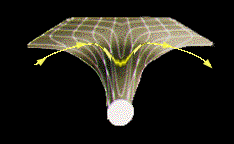WMAP Special Exhibit
Weighing the entire universe: dark matter and dark energy
Counting all the electrons and all the protons in the universe sounds like a daunting task. WMAP will be able to get a pretty good estimate and, in addition, determine the ratio of "ordinary" matter to dark matter and a mysterious force that scientists call dark energy. There's more to the universe than meets the eye. In fact, some scientists think that all we can see is really only 3 percent of the entire universe. Just what exactly is out there?
Ordinary matter is the stuff that we are made of, protons, neutrons, and electrons. Stars, planets, trees, animals – everything we can see or detect with telescopes is ordinary matter, which scientists call baryonic matter.
Dark matter is sometimes called exotic matter. We cannot see dark matter, but we know it is present in the halos of galaxies and in vast galaxy clusters because of its gravitational effect on ordinary, baryonic matter. All particles of matter are attracted to each other through the force of gravity. Dark matter seems to be the "glue" holding galaxies together with all their ordinary matter, for the mass of ordinary matter alone is not enough. Galaxies would fly apart if not for the extra, dark mass.
Some dark matter may be baryonic but simply too dim to see with telescopes. Dark matter may also be exotic, composed of something other than electrons and protons. While WMAP may constrain some of the properties of the dark matter, its main contribution will likely be accurately measuring the mass density of ordinary matter.
Dark energy refers to the force that is accelerating the expansion of the universe. This is an "anti-gravity" force, sometimes referred to as quintessence or a cosmological constant. Gravity pulls things together, and this familiar force should act to slow down the expansion of the universe. Yet the universe continues to fly wide open faster and faster. No one knows why.
So, what will WMAP do? WMAP will determine the number of electrons and protons relative to the number of photons, in the cosmic microwave background. Remember that denser regions in the primordial fog of the early universe attracted more matter. Protons rolled in, and photons (radiation pressure) pushed them back out. This ebb and flow created the vibrations, or sound waves, that rippled through the fog. The density or thickness of that fog, as you might imagine, determines how easily sound waves travel.
Now, remember those "bumps" in the cosmic microwave background? Those are peaks in temperature differences from region to region. Just as the position of those bumps determine the shape of the universe, the size and distance of the bumps relative to each other tell the relative concentrations of electrons, protons and photons. (The number of electrons and protons are more or less equal, which is why the universe doesn't have an electrical charge.)

The path of light being bent by the gravitational field of a massive object. (Credit: NASA/WMAP Science Team)
Bumps in the cosmic microwave background also speak of dark energy. If the universe is flat and composed entirely of matter, then photons will behave in a specific way. Photons, like matter, are attracted by gravity. Einstein described gravity as a well or dent in the fabric of spacetime. Imagine a photon rolling into a well. It gains energy going in and loses energy rolling out. In a flat universe with only matter contributing to the force of gravity, the net energy difference is zero. Roll in, gain; roll out, lose.
If there is dark energy acting in an opposite way to gravity, the depth of those gravitational wells become shallower deep over time. Matter forms the gravitational well, but anti-gravity forces slowly smooth out the well by pulling matter out. Now, when the photon rolls into the well, it has a shorter climb out. The photon picks up energy going in and loses just a little energy coming out. The net energy difference is positive.
The denser regions in that early fog (seen today as slightly warmer regions in the microwave background) had gravitational wells. The low-density regions had "hills" as opposed to wells. Photons roll up the hill and roll down a slope that is less steep because of the action of dark energy. These photons lose energy overall.

WMAP data reveals that the universe's contents include 4.6 percent atoms, the building blocks of stars and planets. Dark matter comprises 24 percent of the universe, and 71.6 percent of the universe, is composed of "dark energy." (Credit: NASA/WMAP Science Team)
Now, back to the bumps in the cosmic microwave background. WMAP will be able to trace photon energy loss and energy gain from region to region – hot spot to hot spot or cold spot to cold spot. If there is dark energy, WMAP would see its effect on the energy of microwave photons at various temperatures and angular scales. That is, WMAP may detect properties in the microwave light that suggest the influence of dark energy. The greater the influence, the higher the contribution of dark energy to the total mass-energy content of the universe.
Earlier experiments have suggested that the universe is about 5 percent ordinary matter, 30 percent dark matter, and 65 percent dark energy. If the stuff we can see is only 1 to 5 percent of what's out there, the universe may be even more fantastic than we ever imagined.
Published: July 2001
Text Reviewed: September 2018


